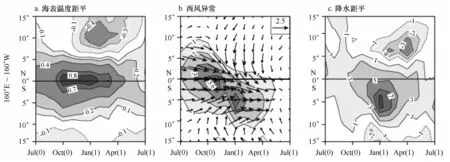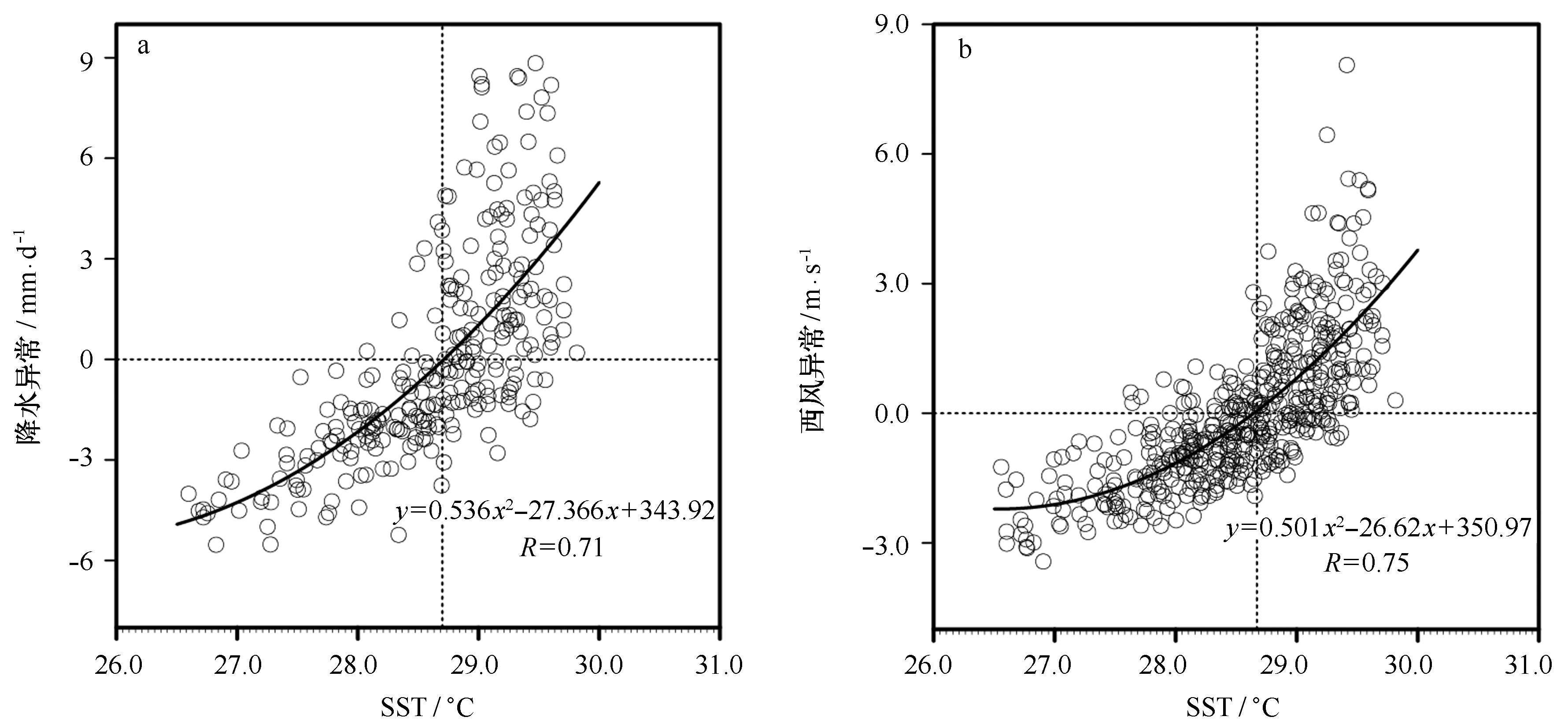SST年循环对El Nio事件局地海气过程的影响
李海燕,张文君*,何金海,王亚兰
(1.南京信息工程大学 气象灾害预报预警与评估协同创新中心 气象灾害教育部重点实验室,江苏 南京210044)
李海燕1,张文君1*,何金海1,王亚兰1
(1.南京信息工程大学 气象灾害预报预警与评估协同创新中心 气象灾害教育部重点实验室,江苏 南京210044)
摘要:利用Hadley中心逐月海表温度、欧洲中心ERA-40的10 m风场及CMAP降水资料探讨了年循环对热带太平洋El Nio海气相互作用过程的影响。尽管El Nio对应的海表温度异常主要出现在赤道东太平洋,经向上呈南北对称分布,然而其对应的大气响应在El Nio年衰减阶段却有着强的向南移动特征。在El Nio发展年的11月之前,强的西风和降水异常主要出现在赤道中太平洋;在12月份之后,赤道上的西风和降水异常迅速南移至5°S,随后西风一直维持在该位置直至衰亡。同时,西太平洋负降水和反气旋异常向北移动。这种SST异常与其大气响应的经向移动不一致,主要是由热带中太平洋气候态SST的季节性南移导致的。由于对流与海温之间存在非线性关系,即当总SST超过一定的阈值,对流降水才会迅速增强;因此相应的对流响应也随着总海温的南移而南移,风场响应也同时南移。此外,南半球增强的对流会通过经向环流进一步抑制北半球的降水,从而使西太平洋负降水和反气旋异常增强并北移。通过分析有/无年循环的两组数值试验结果验证了上述结论,即有年循环的试验较真实地模拟出了观测中异常西风南移和西北太平洋反气旋异常的出现;无年循环试验尽管能模拟出El Nio年赤道中太平洋的西风异常,但其却没有南北向的移动,西北太平洋的反气旋也没有出现。因此,热带中太平洋气候态暖海温的季节循环对El Nio事件大气响应有着至关重要的作用。
关键词:El Nio;年循环;大气响应南移
1引言
自从Bjerknes[9]把大尺度海气相互作用联系起来形成ENSO现象的概念后,大气和海洋科学家围绕ENSO的观测特征、循环机理和可预报性等开展了广泛的研究[10—13]。过去几十年,对于ENSO海气相互作用过程,尤其是ENSO循环机理的物理解释逐步趋于完善[14—25]。Bjerknes[9]最早提出的正反馈理论很好地解释了ENSO发展阶段海表温度(SST)距平快速增长的机理,但是不能解释ENSO冷、暖事件的循环发生。20世纪80年代延迟振子理论[15]引入了负反馈机制来解释El Nio和La Nia事件之间的循环,其机理主要考虑了热带海洋波动在ENSO循环中的作用。在海气耦合过程中,热带海洋受到异常西风强迫时,除了激发向东的暖性Kelvin波,同时也产生向西传播的冷性Rossby波,这种冷性Rossby波传至西太平洋沿岸,反射成为冷性Kelvin东传,冷性Kelvin波将赤道西太平洋的冷异常信号带到赤道中东太平洋,导致El Nio事件的终止,La Nia事件的发展。然而有学者指出太平洋西边界并不存在一个严格意义上的刚壁边界[26—27],因此Rossby波的反射也不一定成立。在此基础上,Jin[17—18]提出了充放电(热)振子理论。根据Sverdrup理论,在El Nio时期,赤道太平洋的西风异常会产生从赤道向两极的经向质量输送,将赤道地区暖水向赤道外输送,从而使得赤道温跃层不断抬升变浅,当其深度浅于气候态时,异常冷的次表层海温通过东太平洋上翻作用使得SST降低并转为负距平,根据Bjerknes正反馈理论,此SST负距平将会快速增强,最终形成La Nia事件,反之亦然。后来的一些研究引入了其他的负反馈机制作为补充,使得ENSO循环理论得到不断地完善[19—20]。
尽管ENSO的循环机理已被很好地解释,但是由于ENSO的复杂性和多变性[11,28—29],人们对ENSO的认识仍在很多方面有待加强。例如,过去对ENSO经向尺度特征及其作用机理一直都没有很好地理解,最近几年的研究发现,ENSO经向尺度存在着冷暖事件的不对称性和显著的年代际变化特征,并从理论上解释了这个观测的特征[30—33]。ENSO纬向位置也发生了明显的变异,一类新的El Nio事件在观测中被发现,其中心不像传统的El Nio处于赤道东太平洋,而是位于赤道中太平洋日界线附近[34—42]。这类新的El Nio事件引起的气候异常与传统事件差异显著,有些区域甚至相反[43—55]。尽管两类El Nio的存在已被科学界接受,然而La Nia是否也可分为两类,目前仍有争议[56—62]。
ENSO现象中还存在着一个目前未被很好理解的现象,那就是ENSO季节锁相问题。一般而言,El Nio事件通常开始于北半球春季或者夏季,在秋季、冬季达到成熟,于第二年春季快速衰减。ENSO显著的季节锁相现象说明ENSO变率与季节循环存在着强的相互作用。尽管一些可能的机理被尝试用来解释ENSO的季节锁相问题,如赤道太平洋海洋波动的季节增幅[63]和热带西北太平洋大气响应的负反馈机制[64],但目前对于ENSO季节锁相的物理机制仍不清楚。伴随着El Nio的衰亡,对应于El Nio异常暖海温的赤道中太平洋西风异常迅速移动至赤道以南5°S左右,这一观测事实早在20世纪80年代就被发现[65—66]。这种西风异常南移主要与西太平洋背景暖海表温度随着太阳辐射的季节性南移相关[67—72]。许多工作指出El Nio年西风异常的南移现象是El Nio迅速衰亡的一个主要原因[67,70—71,73—75]。南移的异常西风使得赤道上的西风异常减弱,从而有利于赤道温跃层向正常状态调整,使得赤道东太平洋的海表温度异常快速消失。El Nio年西风异常南移现象能被赤道表面风经验正交函数分解(Empirical Orthogonal Function)的第二模态所反映,与第一模态(即ENSO模态)相互独立[70—71,76];观测的频谱分析和数值试验已证明,异常西风南移模态是由ENSO相关的变率和热带太平洋暖海温季节循环的非线性相互作用而产生[71—72]。由此可见,热带太平洋背景暖海温年循环对El Nio海气过程的纬向风有重要的影响,这不仅影响着与El Nio相关的海气相互作用,而且会通过遥相关影响全球尺度的气候异常。
为了进一步探索年循环在ENSO相关的海气异常中所起的作用,我们将通过观测和数值试验来研究热带太平洋SST年循环的季节移动是如何影响El Nio所对应的大气响应过程,并着重讨论对热带太平洋局地海气过程中风场和降水场的影响。本文首先通过对观测资料的诊断分析来揭示热带中太平洋地区海表温度异常和相应的大气环流异常的南移现象,再利用GFDL AM2.1大气模式设计有/无年循环作用的两组试验来探讨热带太平洋SST季节性移动对El Nio局地海气相互作用过程的影响。
2资料和方法
2.1资料
本文所用资料包括:(1)英国Hadley中心提供的月平均海表温度(HadISST)资料[77],水平分辨率为1°×1°;(2)欧洲中心(The European Centre for Medium-Range Weather Forecasts)的ERA-40月平均10 m风场[78],水平分辨率为2.5°×2.5°;(3)NOAA的CPC (Climate Prediction Center) CMAP (Merged Analysis of Precipitation)月平均降水资料[79],分辨率为2.5°×2.5°。除了降水资料时间为1979年1月至2001年12月外,其他资料时间跨度皆取1961年1月至2001年12月。
2.2模式介绍与试验设计
AM2.1全球大气模式是地球动力试验室GFDL(Geophysical Fluid Dynamics Laboratory)为气候研究和预测而发展的地球系统模式中的大气模式,该模式集成了过去GFDL所用的模型,它包含了新的格点大气动力核[81]。模式垂直方向上采用混合坐标,由近地的sigma坐标逐渐转为250 hPa以上的p坐标,垂直分为24层,最低层约为30 m,近地面(低于1.5 km)有9层。高层分辨率较粗,对流层上部间隔约2 km,平流层有5层,模式顶气压为3 hPa,水平分辨率(lat×lon)为2°×2.5°。此模式已被应用到大量的海气相互作用的研究当中,并且能较好地模拟出东亚季风及ENSO相关的大气异常结构[71,82]。
(1)第一组试验,记为EX_AC(有年循环试验):替换了热带海洋地区(20°S~20°N)的海表温度,该地区的海温是在气候态海表温度上叠加与ENSO变率相关的海表温度异常(SSTA),ENSO相关的SSTA是由基于表征ENSO事件强度的Nio3.4指数获得,具体是把1961-2001年月平均Nio3.4指数回归到热带地区,得到的回归系数乘以标准化的Nio3.4指数,那么所得到的月平均SSTA就是ENSO相关的海温变率。注意,这里的气候态海温是包含季节循环的,而热带外仅采用气候态海温强迫模式。
(2)第二组试验,记为EX_NO_AC(无年循环试验):热带海洋地区的海表温度只包含ENSO相关的SSTA,而没有与年循环相关的气候态海温。同第一组敏感性试验不一样的是,把气候态海温固定在9月份(9月份太阳直射点在赤道上,赤道中太平洋日界线附近海温呈近似赤道对称分布),此时,热带太平洋的海温没有季节变化特征,只包含ENSO相关的海温变率。
再次说明的是,两组试验中唯一不同的是热带海洋地区SST有/无季节变化,那么模式中大气环流的差异即由SST年循环季节移动引起,因此可以通过对比两组试验来研究海温年循环对El Nio局地海气相互作用的影响。

图1 El Nio事件合成的中太平洋(160°E~160°W)海表温度距平(a)(单位:℃)、纬向10 m风场距平(b)(矢量,阴影为西风异常大小,单位:m/s)和降水距平(c)(单位:mm/d)的纬度-时间的季节演变(横坐标表示El Nio当年7月至翌年7月)Fig.1 Composite latitude-time seasonal evolution of SST anomalies (a) (unit: ℃),10 m wind anomalies (b) (shading indicates westerly wind anomalies,unit: m/s),and precipitation anomalies (c) (unit: mm/d) over the central Pacific (160°E-160°W) during the El Nio events. The abscissa indicates a period from July of year 0 to July of year 1

图2 El Nio事件合成的当年9-12月平均(a)和翌年1-4月平均(b)的10 m风场距平(矢量,通过90%显著性检验,单位:m/s)、降水距平(等值线,间隔为1 mm/d,零线省略;单位:mm/d)及海表温度距平(阴影,单位:℃)的空间分布 Fig.2 El Nio composite SST anomalies (shading in ℃),precipitation anomalies (black contours at intervals of 1 mm/d with zero contours omitted),and 10 m wind anomalies (vector in m/s,shown when westerly and easterly anomalies exceeding the 90% confidence level) for September(0) to December(0) (a) and January(1) to April(1) (b) average
季节演变(图1)和空间季节差异(图2)一致表明了El Nio年海表温度异常和其大气响应场在经向移动上的差异。有关El Nio年冬末的西风异常南移现象早在20世纪80年代就被注意[66]。但西太平洋也存在着负降水和反气旋异常往北的移动并没有被注意到,西太平洋负降水异常的北移对东亚的影响很大,因为中国正处于其西北侧,对应负异常降水的反气旋异常有利于热带洋面上的暖湿水汽往东亚输送。尽管局地的海气相互作用有利于增强反气旋异常[82],最近一些工作指出反气旋是伴随着中太平洋异常西风南移而出现的[71-72],我们在下一部分的数值试验也支持这一观点。
然而,有一个科学问题有待解决,那就是为什么经向分布对称的异常海温强迫出来的大气异常场却有南北向的移动,尤其在El Nio年翌年的冬末春初,大气异常响应场的中心移到了5°S有研究指出这种南移现象是由于背景暖海温随着太阳的季节南移引起的[67,70-71,73—75]。为了寻求背景暖海温季节南移如何引起El Nio翌年1-4月西风及降水异常的南移,首先查看一下热带中太平洋地区1961-2001年平均气候态海表温度的经向分布季节演变特征(图3a)。从图3a中可以看出,热带中太平洋平均的气候态高海温在1-4月份位于赤道以南(5°~10° S),赤道以南的区域基本都超过了28℃,中心达到了29℃,而赤道以北区域海表温度基本低于28℃。从5月份开始,随着太阳加热不断向北移动,中太平洋赤道以北区域海表温度不断增加,最大值出现在9-10月份5°~10° N之间,海表温度超过28.5℃;南半球海温有所减小,但是海表温度最低也能超过28℃,在9-10月海表温度基本上成赤道对称分布;10月以后暖海温中心又向南移动。这种海温的南北季节移动特征是由于太阳直射点的季节性移动引起的。1-4月太阳直射点位于南半球时,使得热带中太平洋气候态SST也从北半球移到赤道以南,这也是一年中南北海温非对称最强的季节,这与El Nio翌年1-4月西风及降水异常明显南移的季节一致。对选取的6次强El Nio事件热带中太平洋海表温度合成(图3b)发现,El Nio发展年7-10月,赤道南北半球都出现了高海温(大于29℃);而随着季节推进,高海温区不断地向南移动,El Nio年翌年的1月份后稳定在南半球,直至衰减。其中在El Nio次年1-4月份,赤道南北海温非对称性最显著,此时赤道以北的海温最低,28.5℃高海温区被限制在5° N 以南。结合图1a,由于异常海温在El Nio发生发展和消亡的过程中,一直都呈现出南北对称分布,因此,图3b中暖海温南移主要是由背景气候态海表温度季节性南移导致的。

图3 热带中太平洋地区(160°E~160°W)气候态SST(a)和El Nio事件合成SST(b)纬度-时间演变(单位:℃)(横坐标表示El Nio当年7月至翌年7月)Fig.3 Latitude-time seasonal evolution of the climatological SST (a) (unit:℃) and the composite of SST(b) (unit: ℃) during El Nio events over the Central Pacific (160°E—160°W). The abscissa indicates a month period from July of year 0 to July of year 1

图4 赤道中太平洋(2°S~2°N,160°E~160°W)海表温度(单位:℃)与降水异常(单位:mm/d)的散点图(a);图(b)同(a),但为SST与西风异常(单位:m/s) Fig.4 Scatter plot of the SST (unit: ℃) and precipitation anomalies (unit: ℃) over the Central Pacific (2°S—2°N,160°E—160°W)(a); (b) same as in (a),but for the mean SST and westerly anomalies (unit: m/s)
和西风异常都有着显著的线性关系,相关系数都超过了0.7(通过95%显著性检验),说明下界面的海温越高,赤道中太平洋对流越强、西风异常越显著。从海表温度和对流异常的散点图中可以看到它们的关系更是呈一个抛物线的关系(图4a中已给出了二次拟合线)。降水异常随海表温度增长的关系表明,其增长速率大概分为两个部分,在小于28.6℃左右,降水异常基本都是负值,对流受抑制;同时其斜率较小,表明随海温增加对流增加的幅度较小。而一旦超过这个阈值,降水异常基本都是正异常;同时对流随海温增加的幅度大大增大,基本呈非线性快速增长(图4a)。正是由于总SST与对流的非线性关系,也就是对流不仅决定于SSTA也决定于总的SST,造成了对流降水随着总的SST南移。结合图3b,在El Nio年大于28.6℃海表温度处于5°N以南区域,南半球海温都超过了29℃,因此正异常降水向南移动(图1c),且中心对应南半球的高海温区。图4a中负降水异常出现在海温低于28.6℃区域,对应赤道以北区域出现的负降水异常。值得注意的是,由于异常降水的南移,使得对流出现非对称性,南半球增强的对流会通过经向环流进一步抑制北半球的降水,从而使得赤道5°N以北降水负异常进一步增强(图1c)。风场异常与海表温度的关系也表现了与降水异常类似的特征(图4b),当降水异常南移的时候风场也一起跟着南移(图1b)。
4数值试验的结果
以上的观测分析揭示了ENSO相关的大气响应场在其成熟后显著南移是由于西太平洋暖海温的季节移动引起的。为了进一步证实这些观测的结果,我们用大气环流模式进行敏感性试验来探索年循环对El Nio局地海气过程的影响。所用模式为美国NOAA的GFDL新一代大气环流模式AM2.1,在本文第二部分的资料与模式中我们己经对该模式和实验设计进行了介绍。
图5给出了两组试验中用到的ENSO相关的异常海温,此异常海温是由Nio3.4指数回归到热带太平洋海温场得到。其空间分布为东正西负的El Nio海温分布型,即中东太平洋为正的异常海温,中心强度达到1℃;西太平洋地区为负海温异常,其强度仅为-0.2℃左右。从图中可以看出,异常海表温度基本呈现经向赤道对称分布。进一步,把Nio3.4指数回归得到的系数乘以标准化月平均Nio3.4指数所得到的海温变率加入到气候态海表温度中,作为大气模式的下界面强迫大气,对模式积分41年(1961-2001年)。第二组试验与第一组试验一致,只是去掉海表温度年循环变化,可见他们下界面都包括了ENSO相关的海表温度异常信息,差异仅是有无年循环。

图5 1961-2001年Nio3.4指数回归的热带太平洋地区海表温度空间分布Fig.5 SST anomalies regressed upon the Nio3.4 index for the period 1961 to 2001

图6 热带中太平洋地区(160°E~160°W) EX_AC(a)和EX_NO_AC(b)试验中El Nio事件合成的海表温度纬度-时间分布(单位:℃)(横坐标表示El Nio当年4月至翌年7月) Fig.6 Composite latitude-time seasonal evolution of the SST (unit:℃) over the central Pacific (160°E—160°W) during El Nio events for EX_AC(a),EX_NO_AC (b). The abscissa indicates a month period from A-pril of year 0 to July of year 1

图7 热带中太平洋地区(160°E~160°W) EX_AC(a)和EX_NO_AC(b)试验模拟结果的El Nio事件合成10 m风场距平纬度-时间演变(阴影为纬向风距平值,单位:m/s)(横坐标表示El Nio当年7月至翌年7月) Fig.7 Composite latitude-time seasonal evolution of the mean 10 m wind anomalies (shading indicates westerly wind anomalies,unit: m/s) over the central Pacific (160°E—160°W) during El Nio events for EX _AC (a),EX_NO_AC(b). The abscissa indicates a month period from July of year 0 to July of year 1

图8 El Nio当年9-12月平均(a、c)与翌年1-4月平均(b、d)合成的风场距平(矢量,通过90%显著性检验,单位:m/s)和降水距平(阴影,单位:mm/d)的空间分布;a、b为EX_AC试验模拟结果,c、d为EX_NO_AC试验模拟结果(横坐标表示El Nio当年7月至翌年7月)Fig.8 Composited surface wind anomalies (vector in m/s,shown when westerly and easterly anomalies exceeding the 90% confidence level) and precipitation anomalies (shading in mm/d) during the El Nio events for the EX_AC experiment (a,c),(a) September-December and (b) January-April average. (c,d) Same as in (a,c),but for EX_NO_AC. The abscissa indi-cates a month period from July of year 0 to July of year 1
5结论和讨论
本文利用Hadley环流中心逐月海表温度、欧洲中心ERA-40的10 m风场及CMAP降水资料,讨论了年循环对ENSO局地海气相互过程的影响。并结合AM2.1模式两组敏感性试验探讨了SST年循环在ENSO局地海气过程中的重要作用。
参考文献:
[1]van Loon H,Madden R A. The Southern Oscillation. Part Ⅰ: Global associations with pressure and temperature in northern winter[J]. Monthly Weather Review,1981,109(6): 1150-1162.
[2]Ropelewski C F,Halpert M S. Global and regional scale precipitation patterns associated with the El Nio/Southern Oscillation[J]. Monthly Weather Review,1987,115(8): 1606-1626.
[3]Ropelewski C F,Halpert M S. Quantifying Southern Oscillation-precipitation relationships[J]. J Climate,1996,9(5): 1043-1059.
[4]Trenberth K E,Caron J M. The Southern Oscillation revisited: Sea level pressure,surface temperatures,and precipitation[J]. J Climate,2000,13(24): 4358-4365.
Chen Wen. Impacts of El Nio and La Nia on the cycle of the Esat Asian winter and summer monsoon[J]. Chinese Journal of Atmospheric Sciences,2002,26(5): 595-610.
[6]黄荣辉,陈文,丁一汇,等. 关于季风动力学以及季风与ENSO循环相互作用的研究[J].大气科学,2003,27(4): 484-502.
Huang Ronghui,Chen Wen,Ding Yihui,et al. Studies on the monsoon dynamics and the interaction between monsoon and ENSO cycle[J]. Chinese Journal of Atmospheric Sciences,2003,27(4): 484-502.
[7]薛峰,刘长征. 中等强度ENSO对中国东部夏季降水的影响及其与强ENSO的对比分析[J]. 科学通报,2007,52(23):2798-2805.
Xue Feng,Liu Changzheng. Influence of Moderate ENSO on summer precipitation over eastern China and its comparative of the strong ENSO[J]. Chinese Science Bulletin,2007,52(23):2798-2805.
[8]李崇银,穆穆,周广庆,等. ENSO 机理及其预测研究[J]. 大气科学,2008,32(4): 761-781.
Li Chongyin,Mu Mu,Zhou Guangqing,et al. Mechanism and predict ion studies of the ENSO[J]. Chinese Journal of Atmospheric Sciences,2008,32(4): 761-781.
[9]Bjerknes J. Atmospheric teleconnections from the equatorial Pacific[J]. Monthly Weather Review,1969,97(3): 163-172.
[10]Latif M,Anderson D,Barnett T,et al. A review of the predictability and prediction of ENSO[J]. J Geophys Res,1998,103: 14375-14393.
[11]Neelin J D,Battisti D S,Hirst A C,et al. ENSO theory[J]. J Geophys Res,1998,103(C7): 14,261-14,290.
[12]Wallace J M,Rasmusson E M,Mitchell T P,et al. On the structure and evolution of ENSO-related climate variability in the tropical Pacific: Lessons from TOGA[J]. J Geophys Res,1998,103(14),169-14,240.
[13]杨辉,李崇银. 厄尔尼诺持续时间与大气环流异常形势[J]. 地球物理学报,2005,48(4):780-788.
Yang Hui,Li Chongyin. Lasting time of El Nio and circulation anomaly[J]. Chinese J Geophys,2005,48(4):780-788.
[14]Wyrtki K. El Nio—the dynamic response of equatorial Pacific Ocean to atmospheric forcing[J]. J Phys Oceanogr,1975,5(4): 572-583.
[15]Schopf P S,Suarez M J. A delayed action oscillator for ENSO[J]. J Atmos Sci,1988,45(21): 3283-3287.
[16]Battisti D S,Hirst A C. Interannual variability in a tropical atmosphere-ocean system: influence of the basic state,ocean geometry,and non-linearity[J]. J Atmos Sci,1989,46(12): 1687-1712.
[17]Jin F F. An equatorial ocean recharge paradigm for ENSO. Part Ⅰ: Conceptual mode[J]. J Atmos Sci,1997,54(7): 811-829.
[18]Jin F F. An equatorial ocean recharge paradigm for ENSO. Part Ⅱ: Astripped-down couple mode[J]. J Atmos Sci,1997,54(7): 830-847.
[19]Picaut J,Masia F,du Penhoat Y. An advective-reflective conceptual model for the oscillatory nature of the ENSO[J]. Science,1997,277(7): 663-666.
[20]Weisberg R H,Wang C. A western Pacific oscillator paradigm for the El Nio-Southern Oscillation[J]. Geophys Res Lett,1997,24(7): 779-782.
[21]张人禾,黄荣辉. El Nio事件发生和消亡中热带太平洋纬向风应力的动力作用Ⅰ.资料诊断和理论分析[J]. 大气科学,1998,22(4): 587-599.
Zhang Renhe,Huang Ronghui. Dynamical roles of zonal wind stresses over the Tropical Pacific on the occurring and vanishing of El Nio Part Ⅰ: Diagnostic and theoretical analyses[J]. Chinese Journal of Atmospheric Sciences,1998,22(4): 587-599.
[22]巢纪平. 厄尔尼诺和南方涛动动力学[M]. 北京: 气象出版社,1993: 2-3.
Chao Jiping. El Nio and Southern Oscillation dynamics[M]. Beijing: China Meteorological Press,1993: 2-3.
[23]严邦良,张人禾. 热带西太平洋风应力异常在ENSO循环中作用的数值试验[J]. 大气科学,2002,26(3): 316-329.
Yan Bangliang,Zhang Renhe. A numerical test of the effects of wind anomaly over the equatorial western Pacific on ENSO cyele[J]. Chinese Journal of Atmospheric Sciences,2002,26(3): 316-329.
[24]陈锦年,宋贵霆,褚健婷,等. 北赤道流区海温异常与ENSO循环[J]. 热带海洋学报,2003,22(4): 10-17.
Chen Jinnian,Song Guiting,Chu Jianting,et al. Anomalous sea temperature of westerward transferring north equatorial current and ENSO[J]. Journal of Tropical Oceanography,2003,22(4): 10-17.
[25]陈锦年,宋贵霆,褚健婷,等. 赤道太平洋次表层海水温度异常的信号通道[J].水科学进展,2003,14(2):152-157.
Chen Jmnian,Song Guiting,Chu Jianting,et al. Oceanic temperature anomalous signal pathway in the equatorial Pacific[J]. Advances in Water Science,2003,14(2): 152-157.
[26]Mantua N J,Battisti D S. A periodic variability in the Zebiak-Cane coupled ocean-atmosphere model:Air-sea interaction in the equatorial Pacific[J]. J Climate,1995,8(12): 2897-2927.
[27]Goddard L,Graham N E. El Nio in the 1990s[J]. J Geophys Res,1997,102(10): 10423-10436.
[28]Trenberth K E,Stepaniak D P. Indices of El Nio Evolution[J]. J Climate,2001,14(8): 1697-1701.
[29]Jin F F,An S I,Timmermann A,et al. Strong El Nio events and nonlinear dynamical heating[J]. Geophys Res Lett,2003,30(3):1120.
[30]Bejarano L,Jin F F. Coexistence of equatorial coupled modes of ENSO[J]. J Climate,2008,21: 3051-3067.
[31]Zhang W,Li J,Jin F F. Spatial and temporal features of ENSO meridional scales[J].Geophys Res Lett,2009,36: L15605.
[32]Zhang W,Jin F F. Improvements in the CMIP5 simulations of ENSO-SSTA meridional width[J]. Geophys Res Lett,2012,39(23): L23704.
[33]Zhang W,Jin F F,Zhao J X,et al. On the Bias in Simulated ENSO SSTA Meridional Widths of CMIP3 Models[J]. J Climate,2013,26(10): 3173-3186.
[34]Su J,Zhang R,Li T,et al. Causes of the El Nio and La Nia amplitude Asymmetry in the Equatorial Eastern Pacific[J]. J Climate,2010,23(3): 605-617.
[35]符淙斌,弗莱彻·J. “埃尔尼诺”(El Nio)时期赤道增暖的两种类型[J]. 科学通报,1985,30(8): 596-599.
Fu Congbin,Fletcher J. Two types of warming over equator during El Nio[J]. Chinese Science Bulletin,1985,30(8): 596-599.
[36]Larkin N K,Harrison D E. On the definition of El Nio and associated seasonal average U.S. weather anomalies[J]. Geophys Res Lett,2005,32(13): L13705.
[37]Ashok K,Behera S K,Rao S A,et al. El Nio Modoki and its possible teleconnection[J]. J Geophys Res,2007,112(C11): C11007.
[38]Kao H Y,Yu J Y. Contrasting eastern-Pacific and central-Pacific types of ENSO[J]. J Climate,2009,22(3): 615-632.
[39]Kug J S,Jin F F,An S I. Two types of El Nio events: Cold tongue El Nio and warm pool El Nio[J]. J Climate,2009,22(6): 1499-1515.
[40]Ren H L,Jin F F. Nio indices for two types of ENSO[J]. Geophys Res Lett,2011,38(4): L04704.
[41]陈圣劼,何金海,吴志伟. 一种新的El Nio海气耦合指数[J]. 大气科学,2013,37(4): 815-828.
Chen Shengjie,He Jinhai,Wu Zhiwei. New ocean atmosphere coupling indices for El Nio[J]. Chinese Journal of Atmospheric Sciences,2013,37(4): 815-828.
[42]陈锦年,王宏娜,王东晓,等. 2009/2010年El Nio事件变化特征及其机理[J]. 海洋学报,2011,33(6): 29-38.
Cheng Jinnian,Wang Hongna,Wang Dongxiao,et al. Variational characteristics analyses of the El Nio event in 2009/2010[J]. Haiyang Xuebao,2011,33(6): 29-38.
[43]Wang Y,Chen J N,Wang H N,et al. Distribution of the tropical Pacific surface zonal wind anomaly and its relation with two types of El Nio[J]. Chinese Journal of Oceanology and Limnology,2013,31(5): 1-16.
[44]Weng H,Ashok K,Behera S K,et al. Impacts of recent El Nio Modoki on dry/wet conditions in the Pacific rim during boreal summer[J]. Climate Dyn,2007,29(2/3): 113-129.
[45]Kim H M,Webster P J,Curry J A. Impact of shifting patterns of Pacific Ocean warming on North Atlantic tropical cyclones[J]. Science,2009,325(5936): 77-80.
[46]Chen G H,Tam C Y. Different impacts of two kinds of Pacific Ocean warming on tropical cyclone frequency over the western North Pacific[J]. J Geophys Res,2010,37(1): L01803.
[47]Feng J,Wang L W,Chen S K,et al. Different impacts of two types of Pacific Ocean warming on Southeast Asia rainfall during boreal winter[J]. J Geophys Res,2010,115(D24): D24122.
[48]Feng J,Li J. Influence of El Nio Modoki on spring rainfall over South China[J]. J Geophys Res,2011,116(D13):D015160.
[49]Zhang W J,Jin F F,Li J,et al. Contrasting impacts of two-type El Nio over the western North Pacific[J]. J Meteor Soc,2011,89(5): 563-569.
[50]Zhang W J,Jin F F,Ren H L,et al. Differences in Teleconnection over the North Pacific and Rainfall Shift over the USA Associated with Two Types of El Nio during Boreal Autumn[J]. Journal the Meteorological Society of Japan,2012,90(4): 535-552.
[51]Zhang WJ,Jin F F,Zhao J X,et al. The possible influence of a non-convectional El Nio on the severe autumn drought of 2009 in Southwest China[J]. J Climate,2013,26(21): 8392-8405.
[52]Zhang Wenjun,Jin Feifei,Turner A. Increasing autumn drought over southern China associated with ENSO regime shift[J]. Geophys Res Lett,2014,41(11),doi:10.1002/2014GL060130.
[53]Xie F,Li J P,Tian W S,et al. Signals of El Nio Modoki in the tropical tropopause layer and stratosphere[J]. Atmos Chem Phys,2012,12(11): 5259-5273.
[54]Yuan Y,Yang S,Zhang Z. Different Evolutions of the Philippine Sea Anticyclone between the Eastern and Central Pacific El Nio: Possible Effects of Indian Ocean SST[J]. J Climate,2012,25(22): 7867-7883.
[55]Wang C,Wang X. Classifying El Nio Modoki I and II by different impacts on rainfall in Southern China and typhoon tracks[J]. J Clim,2013,26(4): 1322-1338.
[56]Cai W J,Cowan T. La Nia Modoki impacts Australia autumn rainfall variability[J]. Geophys Res Lett,2009,36(12): L12805.
[57]Kug J S,Ham Y G. Are there two types of La Nia[J]. Geophys Res Lett,2011,38(16): L16704.
[58]Wang X,Wang D X,Zhou W,et al. Interdecadal modulation of the influence of La Nina events on mei-yu rainfall over the Yangtze River Valley[J]. Adv Atmos Sci,2012,29(1):157-168.
[59]Shinoda T,Hurlburt H E,Metzger E J. Anomalous tropical ocean circulation associated with La Nina Modoki[J]. J Geophys Res,2013,116(C12):C12001.
[60]Zhang Wenjun,Wang Lei,Xiang Baoqiang,et al. Impacts of two types of La Nia on the NAO during boreal winter[J]. Climate Dynamics,2014,44(5): 1351-1366.
[61]王磊,张文君,祁莉,等. 两类La Nia季节演变过程的海气耦合特征对比[J].海洋学报,2014,36(1): 72-85.
Wang Lei,Zhang Wenjun,Qi Li,et al. Contrasting air-sea features associated with two types of La Nia during the seasonal evolution[J]. Haiyang Xuebao,2014,36(1): 72-85.
[62]陈锦年,汪洋,王宏娜,等. 2010/2011年中部型La Nia事件形成机理及其垂直环流异常[J]. 海洋科学进展,2012,30(3): 305-316.
Chen Jinnian,Wang Yang,Wang Hongna,et al. The formation mechanism of the Central Pacific Pattern La Nia event in 2010/2011 and its anomalous vertical circulation[J]. Advances in Marine Science,2012,30(3): 305-316.
[63]Tziperman E,Cane M A,Zebiak S E,et al. Locking of El Nio’s peak time to the end of the calendar year in the delayed oscillator picture of ENSO[J]. J Climate,1998,11(9): 2191-2199.
[64]Guilyardi E,Delecluse P,Gualdi S,et al. Mechanism for ENSO phase change in a coupled GCM[J]. J Climate,2003,16(8): 1141-1158.
[65]Harrison D E. Monthly mean island surface winds in the central tropical Pacific and El Nio events[J]. Mon Wea Rev,1987,115(12): 3133-3145.
[66]Harrison D E,Vecchi G. El Nio-Southern Oscillation sea surface temperature and wind anomalies,1946-1993[J]. Rev Geophys,1998,36(3): 353-399.
[67]Vecchi G,Harrison D E. On the termination of the 2002-03 El Nio event[J]. Geophys Res Lett,2003,30(18): 1964.
[68]Spencer H. Role of the atmosphere in seasonal phase locking of El Nio[J]. Geophys Res Lett,2004,31(24): L24104.
[69]Lengaigne M,Boulanger J,Meinkes C,et al. Influence of the seasonal cycle on the termination of El Nio events in a coupled general circulation model[J]. J Climate,2006,19(9): 1850-1868.
[70]McGregor S,Timmermann A,Schneider N,et al. The effect of the South Pacific Convergence Zone on the termination of El Nio events and the meridional asymmetry of ENSO[J]. J Climate,2012,25(16): 5566-5586.
[71]Stuecker M F,Timmermann A,Jin F F,et al. A combination mode of the annual cycle and the El Nio/Southern Oscillation[J]. Nature Geosci,2013,6(7): 540-544.
[72]Stuecker M,Jin F F,Timmermann A,et al. Combination Mode Dynamics of the anomalous North-West Pacific Anticyclone[J]. J Climate,2014,28(3): 1093-1111.
[73]Harrison D E,Vecchi G A. On the termination of El Nio[J]. Geophys Res Lett,1999,26(11): 1593-1596.
[74]Vecchi G,Harrison D E. The termination of the 1997/98 El Nio. Part Ⅰ: Mechanisms of oceanic change[J]. J Climate,2006,19(12): 2633-2646.
[75]Vecchi G. The termination of the 1997/98 El Nio. Part Ⅱ:Mechanisms of atmospheric change[J]. J Climate,2006,19(12): 2647-2664.
[76]McGregor S,Ramesh N,Spence P,et al. Meridional movement of wind anomalies during ENSO events and their role in event termination[J]. Geophys Res Lett,2013,40(4): 749-754.
[77]Rayner N A,Parker D E,Horton E B,et al. Global analyses of sea surface temperature,sea ice,and night marine air temperature since the late nineteenth century[J]. J Geophys Res,2003,108(D14):4407.
[78]Simmons A. J,Gibson J K. The ERA-40 Project Plan. ERA-40 Project Report Series No. 1[R]. ECMWF,UK,2000:63.
[79]Xie P,Arkin A K. Global precipitation: A 17-year monthly analysis based on gauge observations,satellite estimates and numerical model outputs[J]. Bull Amer Meteorol Soc,1997,78(11): 2539-2558.
[80]Zhang Wenjun,Li Haiyan,Jin Feifei,et al. The annual-cycle modulation of meridional asymmetry in ENSO’s atmospheric response and its dependence on ENSO zonal structure[J]. Climate,2015,28(14): 5795-5812.
[81]The GFDL Global Atmospheric Model Development Team. The New GFDL Global Atmosphere and Land Model AM2-LM2: Evaluation with Prescribed SST Simulations[J]. J Climate,2004,17: 4641-4673.
[82]Fu J J,Li S,Luo D H. Impact of global SST on decadal shift of East Asian summer climate[J]. Adv Atmos Sci,2009,26(2): 192-201.
[83]Wang B,Wu R,Fu X. Pacific-East Asian teleconnection: How does ENSO affect East Asian Climate[J]. J Climate,2000,13(9): 1517-1536.
收稿日期:2015-02-13;
修订日期:2015-07-21。
基金项目:国家重点基础研究发展计划973项目(2012CB417403);公益性行业(气象)科研专项(GYHY 201506013,GYHY201406022);江苏省研究生培养创新工程(CXZZ13_0505),江苏省高校“青蓝工程”。
作者简介:李海燕(1983—),女,广西壮族自治区大新县人,博士,研究方向为ENSO动力学与海气相互作用。E-mail:ncl_talk@126.com *通信作者:张文君(1979—),男,教授,主要从事ENSO动力学、海陆气相互作用等方面研究。E-mail:zhangwj@nuist.edu.cn
中图分类号:P732.6
文献标志码:A
文章编号:0253-4193(2016)01-0056-13
Influence of SST annual cycle on local air-sea processes during El Nio events
Li Haiyan1,Zhang Wenjun1,He Jinhai1,Wang Yalan1
(1.CollaborativeInnovationCenteronForecastandEvaluationofMeteorologicalDisasters,KeyLaboratoryofMeteorologicalDisasterofMinistryofEducation,NanjingUniversityofInformationScience&Technology,Nanjing210044,China)
Abstract:Influence of annual cycle on the local air-sea processes during El Nio events is investigated based on the Hadley Centre (HadISST1) sea surface temperature (SST) analysis data,10 m wind data from the European Centre for Medium-Range Weather Forecasts (ECMWF) ERA-40 reanalysis and the CMAP precipitation data. In the observation,SST anomalies associated with El Nio over the equatorial eastern Pacific are meridionally quasi-symmetric about the equator. However,corresponding atmospheric responses display a strong southward movement during the El Nio decaying phase. During the El Nio developing phase (largely before November),almost meridionally symmetric zonal wind and precipitation anomalies are observed over the equatorial central Pacific. After the El Nio peak month (about December),the equatorial westerly and precipitation anomalies shift rapidly southward with a center at about 5°S. Then the zonal wind anomalies stay there till the El Nio’s termination. Meanwhile,negative precipitation and anticyclonic anomalies over the western Pacific shift northward. The inconsistence of the meridional movements of the El Nio SST anomalies and the associated atmospheric responses is mainly due to seasonally southward displacement of background warm SSTs along with the seasonal march of solar insolation. There is nonlinear relationship between convection and overall SST. That is,convective precipitation will be rapidly enhanced when total SST exceeds a certain threshold. Thus the corresponding convection anomalies are also displaced southward along with the southward shift of the SST and the zonal wind anomaly also appears south of the equator. In addition,the precipitation over northern hemisphere will be further suppressed due to the enhanced convection in southern hemisphere trough the meridional circulation,which can enhance the negative rainfall and anticyclone anomalies in the western Pacific and move northward. These observed analyses are supported by two experiments with and without considering the annual cycle. Southward shifts of the westerly anomalies and anticyclonic anomalies over the western North Pacific during the El Nio decaying phase are well simulated by the experiment with the annual cycle. However,these observed phenomena are not reproduced by the experiment without consideration of the annual cycle. Therefore,the annual cycle of climatological warm SSTs over the central Pacific plays a crucial role on the local atmospheric responses during the El Nio events.
Key words:El Nio; annual cycle; southward shift of atmospheric response
李海燕,张文君,何金海,等. SST年循环对El Nio事件局地海气过程的影响[J]. 海洋学报,2016,38(1): 56-68,doi:10.3969/j.issn.0253-4193.2016.01.006
Li Haiyan,Zhang Wenjun,He Jinhai,et al. Influence of SST annual cycle on local air-sea processes during El Nio events[J]. Haiyang Xuebao,2016,38(1): 56-68,doi: 10.3969/j.issn.0253-4193.2016.01.006

